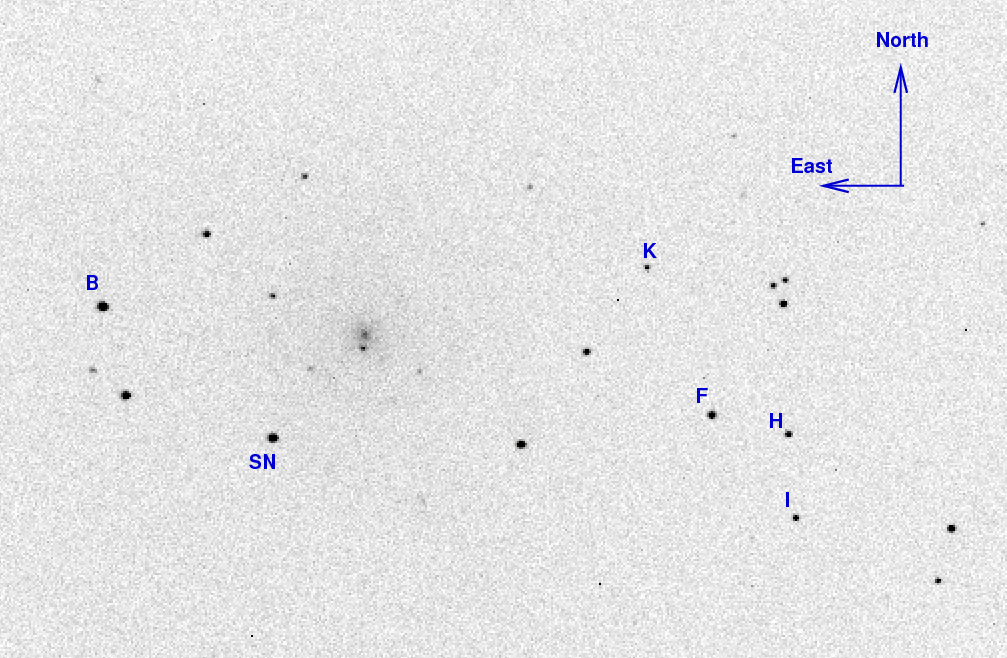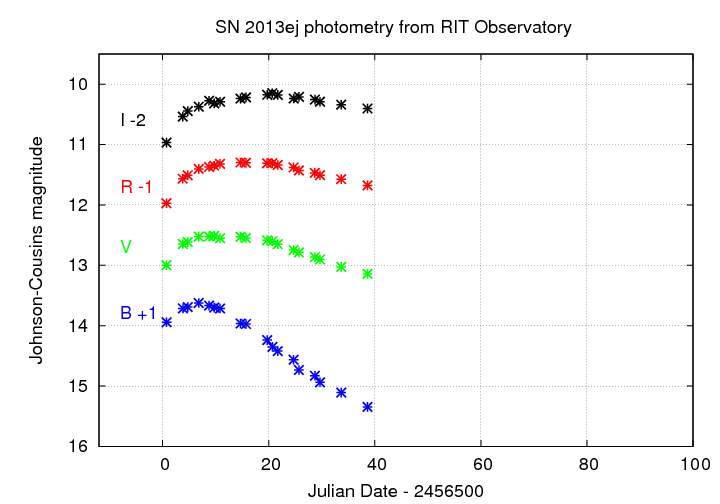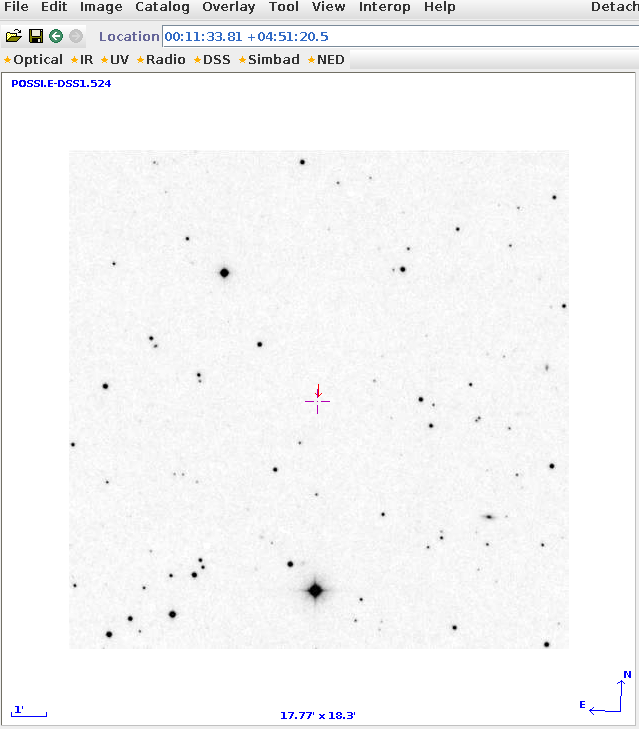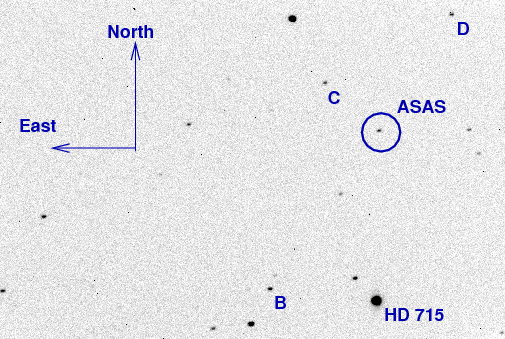
On the night of Sep 02/03, 2013, I observed SN 2013ej in M74, as well as checking UZ Boo and the new cataclysmic variable ASASSN-13ck. Conditions were good at first, but clouds approached just as the SN was rising in the east. I managed to get a few images.
The main setup was:
Notes from the night
SN 2013ej is a Type II supernova in the relatively nearby galaxy M74. It was discovered by the KAIT group about one week before maximum light. Here's a chart showing the galaxy, the SN, and some reference stars:

The reference stars marked above have magnitudes in AAVSO chart 12459CA, as follows:
letter B sigB V sigV R sigR I sigI B 13.012 0.019 12.510 0.019 12.154 0.019 11.834 0.019 F 13.848 0.026 13.065 0.022 12.622 0.025 12.152 0.027 H 14.338 0.029 13.692 0.024 13.329 0.029 12.964 0.030 I 14.832 0.027 13.912 0.023 13.416 0.026 12.939 0.030 K 15.192 0.034 14.613 0.027 14.275 0.034 13.915 0.036
I took 30-second guided images in VRI, but the B-band is so insensitive that, as usual, the guider couldn't hold the guide star reliably. After discarding the bad images, I was left with 8, 4, 4, and 5 images in B, V, R, and I, respectively. . On this night, I did not have time to focus in the I-band (as clouds were coming), so the I-band images are slightly out of focus.
Using aperture photometry with a radius of 4 pixels (radius of 7.4 arcsec), I measured the instrumental magnitudes of a number of reference stars and the target. Following the procedures outlined by Kent Honeycutt's article on inhomogeneous ensemble photometry, I used all stars available in each image to define a reference frame, and measured each star against this frame. I used the AAVSO magnitudes, plus color terms to convert the ensemble instrumental magnitudes to the standard Johnson-Cousins BVRI scale.
Results from this evening are:
filter mag mag_uncert Julian Date B = 14.346 +/- 0.140 (ens 0.129 zp 0.054) 2456538.62743 V = 13.142 +/- 0.034 (ens 0.027 zp 0.020) 2456538.62004 R = 12.677 +/- 0.021 (ens 0.010 zp 0.018) 2456538.61737 I = 12.403 +/- 0.062 (ens 0.059 zp 0.019) 2456538.62575
The uncertainties here are dominated by extracting the instrumental magnitudes.
Grab the text file below for all the RIT measurements of SN 2013ej. All these values have been recomputed with the new color terms of UT 2013 Aug 05.

The All-Sky Automated Survey for Supernovae at Ohio State has found a number of interesting variable stars in addition to supernovae. You can read all about their "transients" at http://www.astronomy.ohio-state.edu/~assassin/transients.html . One of those is called "ASASSN-13ck", and is an interesting cataclysmic variable star.
RA = 00:11:33.71 Dec = +04:51:23
Here's a chart of the region from the DSS:

I took a short series of 30-second V-band images of the field last night while waiting for SN 2013ej to rise above the trees. This star is pretty close to SN 2013ej in the sky. One of our images is shown below: the field of view is about 15-by-10 arcminutes.

The stars marked "B", "C", and "D" have magnitudes provided by the AAVSO, in their sequence 12635FGO:
# # Report this sequence as: 12635FGO in the chart field of your observation report. # # AUID RA. Dec. my B V B-V Rc Ic 000-BLD-228 0:12:23.76 4:37:23.8 117 12.407 (0.081) 11.745 (0.056) 0.662 (0.098) 11.555 (0.419) 11.373 (0.590)29 000-BLD-229 0:11:35.97 5:01:27.5 122 12.839 (0.062) 12.183 (0.034) 0.656 (0.071) 11.998 (0.438) 11.820 (0.619)29 000-BLD-230 0:11:52.92 4:41:53.2 125 13.265 (0.090) 12.543 (0.049) 0.722 (0.102) 12.368 (0.432) 12.200 (0.609)29 000-BLD-231 0:12:16.60 5:01:36 127 13.304 (0.072) 12.696 (0.049) 0.608 (0.087) 12.490 (0.480) 12.293 (0.676)29 000-BLD-232 0:11:57.29 4:44:45.3 131 13.860 (0.081) 13.065 (0.056) 0.795 (0.098) 12.826 (0.446) 12.598 (0.628)29 000-BLD-233 0:11:47.66 4:46:26.2 B 136 14.235 (0.093) 13.603 (0.053) 0.632 (0.107) 13.411 (0.444) 13.226 (0.626)29 000-BLD-234 0:11:51.00 4:59:53.2 138 14.476 (0.086) 13.843 (0.052) 0.633 (0.100) 13.723 (0.461) 13.604 (0.650)29 000-BLD-235 0:11:24.39 4:55:00.5 D 141 15.140 (0.072) 14.146 (0.033) 0.994 (0.079) 13.613 (0.113) 13.116 (0.156)29 000-BLD-236 0:11:40.47 4:52:53.9 C 144 15.127 (0.082) 14.357 (0.048) 0.770 (0.095) 14.148 (0.469) 13.948 (0.662)29 000-BLD-237 0:11:35.79 4:57:58.4 147 15.780 (0.085) 14.693 (0.046) 1.087 (0.097) 14.304 (0.495) 13.939 (0.699)29 000-BLD-238 0:11:52.60 4:53:01.2 155 16.521 (0.112) 15.497 (0.045) 1.024 (0.121) 15.215 (0.379) 14.948 (0.534)29
The few measurements I was able to make on this night show clearly that I'll need much longer exposures in V-band to get good signal-to-noise ratio on this star.
Last modified 09/03/2013 by MWR.